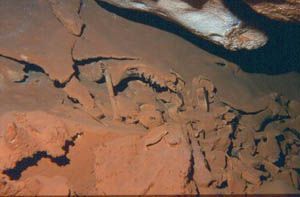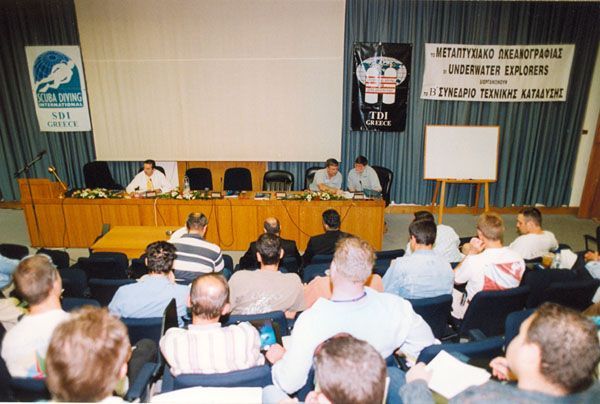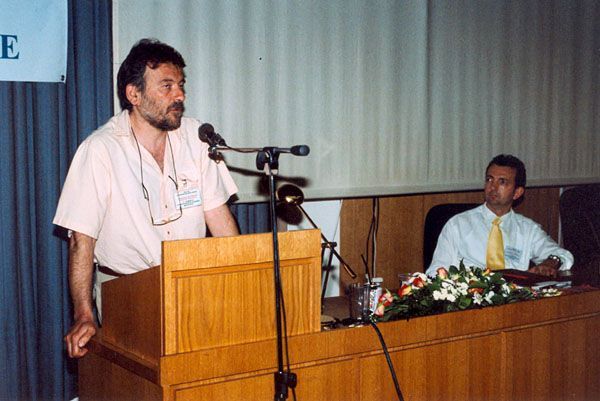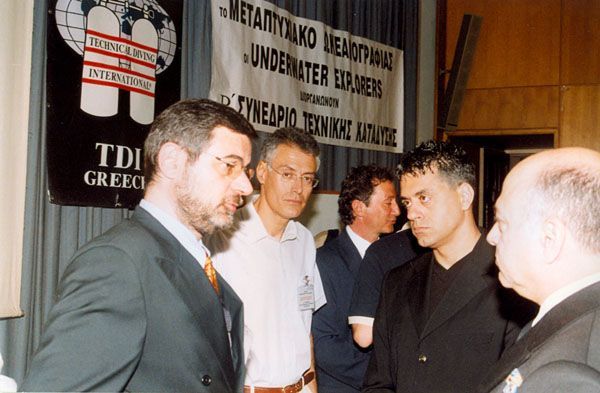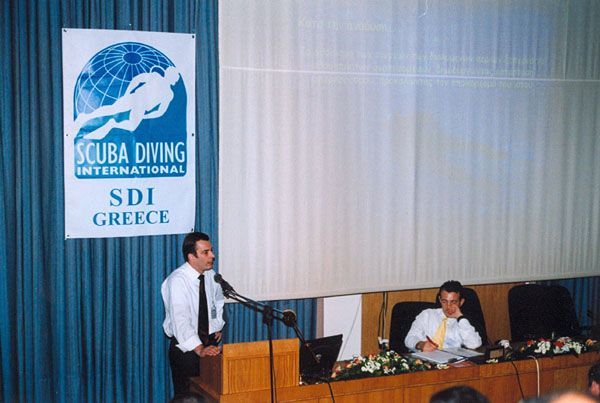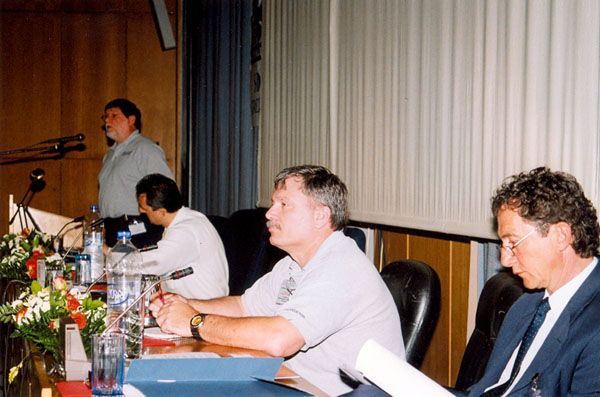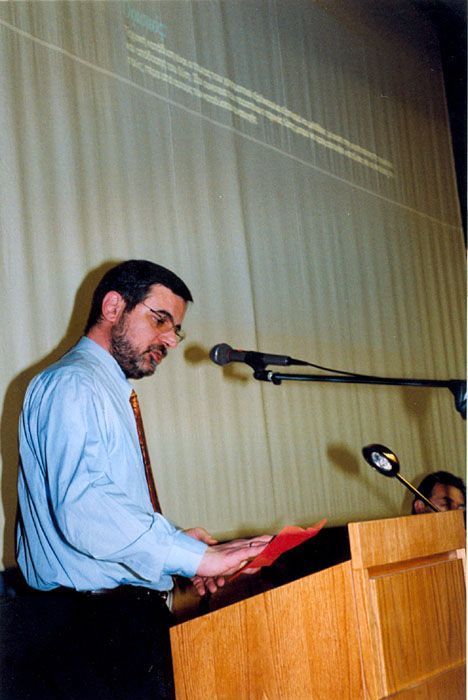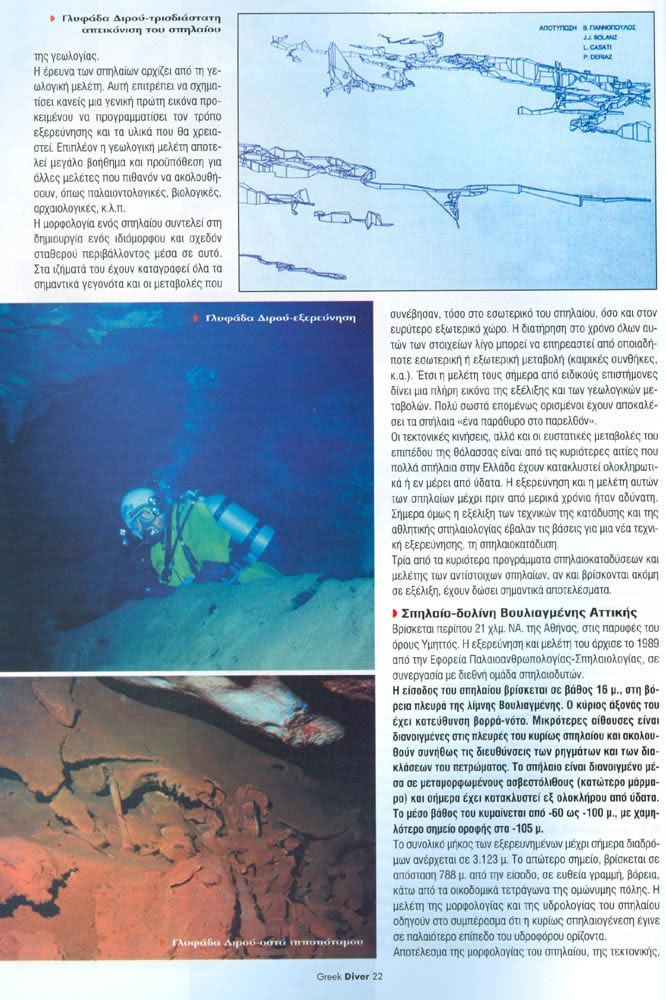2nd Amateur & Technical Diving Conference
Sunday, May 4, 2003
Άρθρο: Γιώργος Πέτρου
Το Συνέδριο για 2η φορά συνδιοργάνωσαν με απόλυτη επιτυχία οι Hellas Underwater Explorers - TDI/SDI (Εκπαιδευτής Εκπαιδευτών Γεώργιος Πέτρου) και το Μεταπτυχιακό Ωκεανογραφίας του Πανεπιστήμιου Αθηνών (Διευθύντρια Κα Αποστολοπούλου Μαρία).
The conference was once again held in the ideal Dracopoulos Hall of the University of Athens (30 Panepistimiou Street, Athens), which is ideal for such events. The hall (capacity 150 people) was almost full, and had all the necessary audiovisual systems such as a Digital Projector, Sound System, Slides, Transparencies, whiteboard, microphones and everything else for a flawless event. The fact that such an event is repeated for the 2nd time again means that it tends to become an institution. I remember in 2001 when I attended the 1st Conference that everything that was said was extremely important and I had the feeling that I had heard everything. Taking the announcement with the new program of speakers and topics into my hands, I was really excited and waited for the day of the Conference to come. I had high expectations for the new conference, given that the first one had received excellent results from an organizational perspective. It is worth noting that this second conference, unlike the first one, had a very strong orientation towards amateur diving.
The Value of Holding the Conference
We could divide the usefulness of the Conference into 3 basic categories:
- 1st For the younger scuba divers. For them it is important that they start their diving career with the most ideal conditions as there is a plurality of sources of information as well as an excellent perspective for the future. Let us not forget our poor past in which there were no manuals, there were no beaches free for diving, there was no equipment and the diving process was nothing more than a closed circuit of people. This Conference was nothing but a great breath of upgrade and progress.
- 2nd For the older ones who came to the conference, they proved their love for diving and that they remain lovers of learning. We really heard a lot of discussions about how much has changed and how terrible the lack of information they have had in recent years is.
- 3ον Μοναδικό Μελανό σημείο. Για τους επαγγελματίες (εκπαιδευτές αυτοδυτών) της κατάδυσης που δεν ήρθαν στο Συνέδριο και μας κάνουν να αναρωτηθούμε...
- Δεν τους ενδιαφέρουν οι εξελίξεις στους τομείς της κατάδυσης? Φυσιολογία, πίνακες κλπ... - 1. Are they not interested in teaching modern and certainly certified knowledge and practices to their students? 2. Are they not interested in contributing to development? 3. Does their non-presence have to do with their opposing view of the existence of such an institution? 4. Does their non-presence have to do with their opposition to the organizing company? 5. Does their non-presence have to do with their opposition to the presence of the specific Speakers?
Η μέρα του Συνεδρίου
Conference day, and as I arrive early in the morning I notice that quite a few people were already there before me. Quite a few people from the countryside proved with their presence their thirst for diving and participation in the developments. And of course many well-known people. At the entrance to the university there were several informative arrows which allowed us to "orientate" correctly and reach the conference hall. At the entrance to the hall there was a large reception table where the executives of the organizing company registered the attendees, and handed them a very elegant folder that had been provided by the TDI/SDI organization. The conference started half an hour late with the organizer Mr. George Petrou welcoming the audience and inviting Mr. Vourekas (Representative of the TDI/SDI organization) to greet the event. In the first rows of the auditorium, in addition to academics such as the Director of the Postgraduate Program in Oceanography of the University of Athens, Ms. Apostolopoulou, we also saw many other important diving executives such as Mr. Papadakis Ioannis (Commander of the Hellenic Diving Association), Messrs. Ronaldo Valencia (TDI/SDI Mexico), Michal Piskula (TDI/SDI Czech Republic) who attended exclusively for the conference. And of course many famous and unknown diving figures.
I must thank my colleagues and collaborators Ch. Agouridis and Th. Kontrolozos, cave divers JJ Bolanz, L. Casati, M. Douchais and the rest of their international team.
Also, thanks are due to the Mayor of Vouliagmeni, Mr. G. Kasidokostas for supporting the Vouliagmeni program, and to A. Cavallieros and Th. Chilioudakis for the technical support of the missions.
The organizer Mr. Petrou Georgios of the organizing company HELLAS UNDERWATER EXPLORERS feels the need through the columns of our magazine to thank those who contributed to the organization and realization of this conference.
- The Postgraduate Program in Oceanography of the University of Athens and the Director Ms. Apostolopoulou Maria
The speakers - scientists of the Conference who generously and immediately responded and shared with us their precious treasure of knowledge:
- Dr. Anastasiadis Nikos, Biologist specialized in diving physiology
- Υποπλοίαρχο Dr. Βαβάση Παύλο, Π.Ν. Επιμελητής Καταδυτικής Υπερβαρικής Ιατρικής ΝΝΑ
- Vasilios Giannopoulos, Cave Diver, Doctor of Geology of the Ephorate of Paleoanthropology - Speleology
- Lieutenant Commander Dr. Zachariadis Vasilis, RN, Hyperbaric Medicine - Director of the Department of Hyperbaric Medicine, NNA
- Dr. Kotilea Panagiotis, Cardiologist - Trained in Diving Medicine, Scuba Instructor
- Dr. Theodoros Papastavrou, Director of the Medisub Institute
- Dave Crockford Manager SDI / TDI / ERDI Europe
- Joe Odom Training manager of TDI Worldwide
The official guests who honored the Conference with their presence.
Greek Diver magazine, All the scuba divers and instructors who attended and honored the Conference with their presence.
This Conference was supported by the most important scientists in the field of diving not only at a Greek but also a World level, a fact that makes it a top European event. We are all eagerly awaiting the 3rd Amateur & Technical Conference
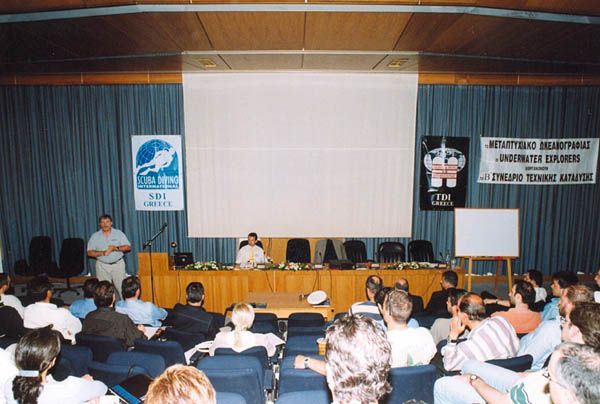
This Conference was supported
one of the most important scientists in the field of diving, not only at a Greek but also a global level.
A fact that makes it a top European event.
Περιμένουμε όλοι μας με ανυπομονησία το 3ο Συνέδριο
Amateur & Technical Diving.
The 3 main topics of the conference:
- PHYSIOLOGY
- CAVES IN THE WEST
- Presentation for the first time in our country of the Amateur Diving Organization SDI (Scuba Diving International)
The conference speakers were the following:
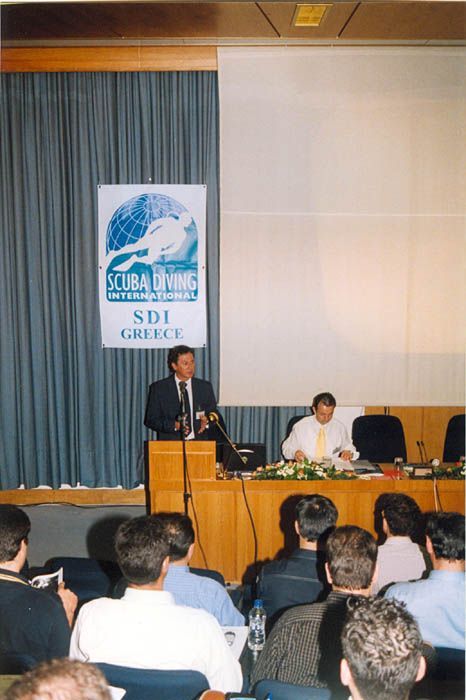
1st Speaker known to all of us
Dr. Anastasiadis Nikos
Biologist specialized in diving physiology and of course 3*** instructor of the Greek Diving Association and president of the Association of Greek Instructors.
Mr. Anastasiadis spoke about: Gas Mixtures in Amateur & Technical Diving and as always his speech was extremely full of up-to-date and useful information for everyone. Mr. Anastasiadis focused particularly on EANITROX and developed its positive and negative data. Absolutely convincing as always and with documented opinions as he is one of the most knowledgeable on the subject. He skillfully involved mixtures, physiology, risks and procedures. At the end he presented his personal opinions and experiences. Characteristic as always in his manner of expression, he kept his audience interested until the last second of his speech. His presence as president of the Association of Greek Instructors was particularly important and symbolic.

2nd Speaker: Mr. Dave Crockford, who is the Training Manager and Head of Administration of SDI / TDI / ERDI Europe, based in England.
With a very sweet and at the same time serious appearance, and with a strong professional orientation, Mr. Crockford introduced us to the organization that has essentially shaken the establishment in the field of Amateur diving. And we are talking about no other organization than SDI (Scuba Diving International) which has been developing extremely dynamically in recent years. Within one hour of his speech we found that SDI is a very well-organized Amateur diving organization that is powered by the Know-how and prestige of TDI (Technical Diving International). The largest Technical diving organization in the world.
Ποιοτικό και ευέλικτο εκπαιδευτικό πρόγραμμα με μεγάλο πλουραλισμό προσφερόμενων υπηρεσιών. Θα λέγαμε ότι πρακτικά αν και αρχικά μας φάνηκε ότι στέκεται κάπου ενδιάμεσα με
CMAS & PADI γρήγορα καταλάβαμε πως διαθέτει μια εντελώς δική της φιλοσοφία πρακτικής εκπαίδευσης. Επαγγελματικός τρόπος εκπαίδευσης, σεβασμό, σοβαρότητα και προθυμία προς μαθητή-πελάτη, δυνατό πρόγραμμα υποβρυχίως με ιδιαίτερες απαιτήσεις όχι μόνον στην ανάπτυξη ικανοτήτων δεξιοτεχνίας αντιμετώπισης περιστατικών αλλά και στην δημιουργία υψηλού επιπέδου στην πρόληψη και την σωστή νοοτροπία.
Όσο για την προσφερόμενη υλικοτεχνική υποδομή μάλλον θα αστειεύεστε
SDI was very well prepared before it officially started operating as an organization for almost a decade. Manuals clearly more modern and more up-to-date than the competition with all the pages of its books in color. Amazing design reminiscent of a broad magazine. So pleasant. But their material more than compensates you as it has been an amazing job. Power point, video, tables, slates, stickers, T-Shirts, Log book and everything else you can imagine are available to its members. The Advanced Development course program is very impressive, which innovates in many ways as it aspires to certify True scuba divers as Mr. Crockford told us. It is really important that SDI/TDI already has a Local support office for its members in our country.
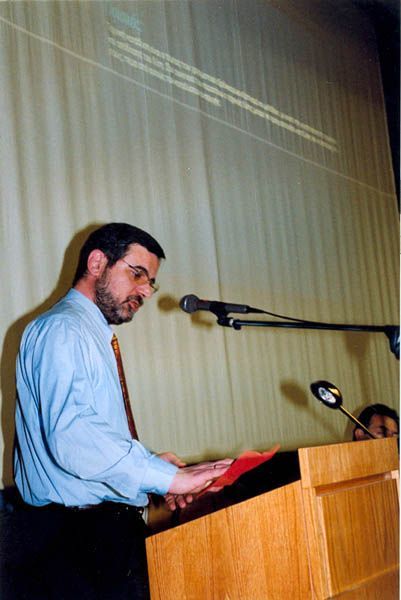
3rd Speaker Mr. Zachariadis Vasilis (Lieutenant Commander of the Hyperbaric Medicine Department - Director of the Hyperbaric Medicine Department of the Hellenic Navy).
After a 10-minute break, it was the turn of the 3rd Speaker, Mr. Zachariadis Vasilis (Lieutenant Commander of the Hellenic Navy's Hyperbaric Medicine Department - Director of the Hellenic Navy's Hyperbaric Medicine Department).
And Mr. Zachariadis' topic could not have been other than: The effect of changing inhaled mixtures on the creation & volume of bubbles. Occurrence of Divers' Disease & treatment in the Decompression Chamber. Mr. Zachariadis, for those who know him, agree that he is an extremely intense and characteristic speaker who does not embellish reality but calls things by their name. His words were intensely enlightening and warning to all interested parties. With hard examples, he often developed his topic, covering and revealing many aspects of it. He kept the audience's interest until the last moment and fortunately there was a time limit for questions because we would still be there and he would answer questions from his audience. Simple, essential in speech and content. Let's not forget that he is also the Manager of the Hyperbaric chamber (chambers) of NNA.
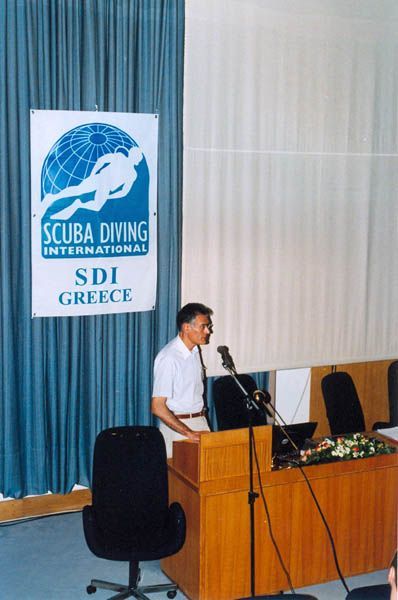
4ος Ομιλητής Ο Dr. Κοτιλέας Παναγιώτης, Καρδιολόγος - Εκπαιδευμένος στην Καταδυτική Ιατρική, Εκπαιδευτής Αυτοδυτών
ο οποίος και μίλησε για το PFO Ανοιχτό Ωοειδές Τρήμα και ο ρόλος του στην φυσιολογία της κατάδυσης.
O Κος Κοτιλέας, συνεργάτης του κυρίου Ζαχαριάδη πραγματικά κράτησε το ενδιαφέρον του ακροατηρίου καθώς κατ΄ αρχήν είχε διαλέξει ένα θέμα διαφορετικό και εξαιρετικά ενδιαφέρον. Με προσοχή τον ακούσαμε να μας εξηγεί το τι σημαίνει PFO, γιατί μας ενδιαφέρει, πώς λειτουργεί αυτό, υπό ποιες συνθήκες συμβαίνει, πως αντιμετωπίζεται, τι αποτέλεσμα έχει και πολλές άλλες ενδιαφέροντες πληροφορίες. Μάλλον δεν είχαμε όλοι μας αντιληφθεί, συνειδητοποιήσει μέχρι τώρα την συχνότητα της παρουσίας του καθώς και την σοβαρή του επίδραση αυτού στον ανθρώπινο οργανισμό κατά την διάρκεια της κατάδυσης. Πολύ οπτικό υλικό συνόδευε την παρουσίασή του και το οποίο έκανε αυτήν ευχάριστη και ευκολοκατανόητη, Βροχή οι ερωτήσεις και στον Κο Κοτιλέα ο οποίος πιστεύω πως θα έπρεπε να είχε ακόμη περισσότερο χρόνο για να δεχτεί και άλλες ερωτήσεις. Πολύ ενδιαφέρον θέμα και πολύ ωραία ομιλία.
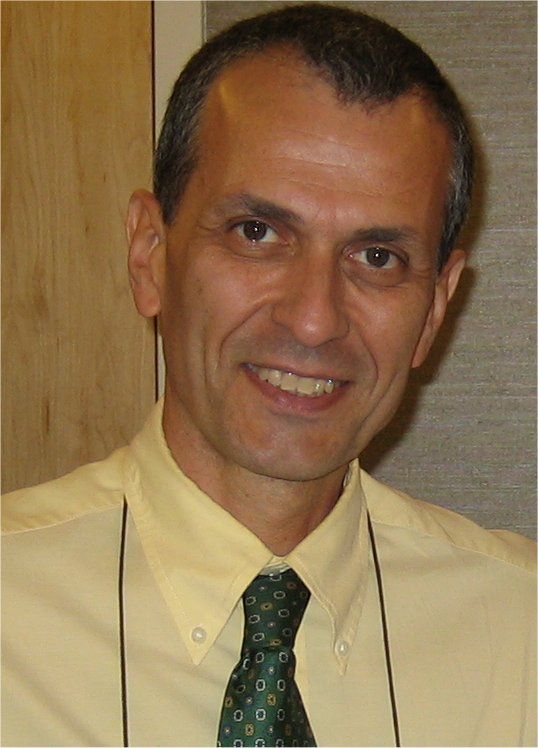
5ος Ομιλητής Dr. Θεόδωρου Παπασταύρου, Διευθυντή του Ινστιτούτου Medisub
θέμα:
Δηλητηριάσεις Αερίων στην Κατάδυση
Ο κος Παπασταύρου πέραν του εξαίρετου χαρακτήρα του, είναι γνωστός από τα καταδυτικά συγγράμματα του με τα οποία έχουμε όλοι μας μεγαλώσει καταδυτικά. Και ποιος δεν έχει και από ένα εγχειρίδιο μία φωτοτυπία που έχει γράψει ο Κος Παπασταύρου. Ύλη πολύ σημαντική. Όπως και στο 1ο Συνέδριο ο κος Παπασταύρου με το χαρακτηριστικό του λεξιλόγιο και γραφή αποφάσισε να μας μιλήσει - αναπτύξει ένα τόσο σημαντικό θέμα όπως οι Δηλητηριάσεις. Συμπαγή δομή παρουσίασης με ξεκάθαρη ύλη και σωστό προσανατολισμό τοποθετήσεων από ένα βαθυστόχαστο (εάν μου επιτρέπεται ) ομιλητή και άριστο γνώστη τόσο της γλώσσας όσο και της κατάδυσης.
Let's look at the framework of Mr. Papastavrou's presentation. If some of you are surprised by Mr. Papastavrou's spelling, you should know that it is pretentious and certainly not incorrect.
For more information, contact him.
"Gas Poisonings in Diving"
CARBON DIOXIDE POISONING
Causes: Insufficient ventilation of the lungs, due to:
- * Εκούσιο υποαερισμό, για λόγους οικονομίας αέρος.
* Μεγάλο αναπνευστικό νεκρό όγκο.
* Στολή μικρού μεγέθους.
* Βαρειά εργασία υποβρυχίως.
* Βλάβη στο ρυθμιστή αναπνοής SCUBA.
* Βλάβη στο κάνιστρο συσκευής κλειστού ή ημικλείστου κυκλώματος UBA.
* Βαθειές καταδύσεις με ατμοσφαιρικό αέρα ή άλλα μίγματα, σχετικώς πλού¬σια σε οξυγόνο (σε σχέσι με το βάθος), σε συνδυασμό με βαρειά εργασία.
* Υπαρξι καυσαερίου στο αναπνεύσιμο μίγμα.
Εκδηλώσεις:
- * Tachypnea.* Feeling of lack of air.* Unexplained tachycardia. * Dizziness.* Nausea-Vomiting.* Headache, which worsens when hypercapnia ceases. * Mental confusion and loss of consciousness.* Burning in the eyes.* Peripheral vasodilation (especially with a mixture rich in oxygen).* Cyanosis of the face
First aid:
- * Immediate cessation of all work. * Deep and calm breathing. * Flushing the system with clean air or a mixture. * Ascent to a shallower depth. * Change of breathing mixture, to a higher oxygen content, up to the maximum permitted partial pressure (most educational organizations place the safety limit at 1.5 ATA, but 1.6 ATA is also safe underwater, while in a dry environment the safety limits rise up to 2.8 ATA). * Transport to a general hospital.
Complications: Predisposition to:
- * Nitrogen narcosis. * Decompression sickness. * Decreases resistance to physical fatigue. * Panic attacks.
CARBON MONOXIDE POISONING
Causes: High carbon monoxide content of the breathable mixture, due to:
- * Βλάβη του αεροσυμπιεστού πληρώσεως φιαλών.
* Κακή τοποθέτησι της εξατμίσεως του αεροσυμπιεστού, ως προς την εισαγωγή αέρος.
Εκδηλώσεις:
- * Malaise* Headache.* Feeling of shortness of breath.* Dizziness-Vertigo.* Nausea-Vomiting.* Mental confusion-Irritability.* Unsteadiness and slurred speech (on land).* Exhaustion.* Weak pulse. * Cyanosis of the lips, mucous membranes and oral cavity.* Coma and death.* Cherry-red lips and mucous membranes (forensic postmortem sign).
First aid:
- * Immediate ascent to the smallest permitted depth.* Cessation of breathing of the contaminated mixture.* Administration of the richest permitted and available oxygen mixture.
(most educational organizations place the safety limit at 1.5 ATA, but 1.6 ATA is safe underwater, while in a dry environment the safety limits rise to 2.8 ATA).* Cardiopulmonary resuscitation (if the victim is pulseless).* Transfer to a hyperbaric medical or intensive care unit is required.
Complications:
- * Panic.* Drowning.* Death.
ΔΗΛΗΤΗΡΙΑΣΗ ΑΠΟ ΟΞΥΓΟΝΟ
Causes: Exceeding the tolerance of the CNS and/or lungs to oxygen, due to:
- * Breathing oxygen at a partial pressure greater than 2 ATA, on land. * Violating oxygen exposure tables underwater.
Εκδηλώσεις:
- * Tinnitus (ringing or buzzing in the ears).* Dizziness-Vertigo-Nausea.* Numbness and twitching of the lips and facial muscles.* Inability to concentrate.* Disorientation.* Unusual feeling of fatigue.* Breathing disorders, such as hyperpnea - apnea or dyspnea.* Euphoria-feeling of intoxication.* Visual disturbances - tubular vision.* Loss of consciousness. * Convulsions.
First aid:
- * Change breathing mixture to a lower partial pressure of oxygen.* If the victim is performing a decompression stop with oxygen, take 5-minute breaks with air every 20 minutes.* If the victim has convulsions: * Keep the breathing regulator in his mouth. * Lift very slowly, once the convulsions stop. If the convulsions are prolonged, attempt a very slow lift.* If the victim requires therapeutic recompression and has used oxygen-rich mixtures, keep a note of the oxygen load he has on the CNS and lungs, and inform the physician.
Complications:
- * Drowning.* Aspiration.* Death.

6th Speaker The Lieutenant Commander
Dr. Vavasis Pavlos, P.N. Curator of Diving Hyperbaric Medicine, NNA
Unremarkable from the most likeable personalities in the diving world, with an excellent character. Mr. Vavasis had as his topic: "Answers to basic questions of scuba divers on diving issues". What did this topic want (in a good way). This presentation was essentially not a presentation but exactly what the audience wanted. Questions and clear answers - positions on many issues-questions that torment the Greek, the modern scuba diver. There are many issues that are disputed, where opinions differ. Bath after diving, aspirin yes or no and how effective is it in the end? Decompression with EAN 80 or 100% O2? And many more... and you understand what happened. And it's a good thing that there was a time limit for presentation and questions. Mr. Vavasis answered a very large number of simple but also specialized questions that were finally answered. We firmly believe that regardless of the presentation each speaker makes, they should take care, just like Mr. Vavasis, to take a direct and clear position on each issue.
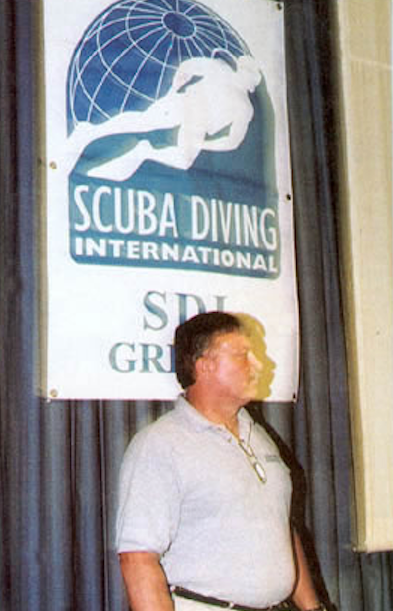
7th Speaker Joe Odom, a very important event and honor for all of us, his presence and speech at the Conference.
Mr. Joe Odom is currently one of the key executives of TDI USA, he is the Training Manager of TDI and the Training Coordinator. He was the President of the USA Caving Federation NACD with experience of thousands of cave dives and training of cave diving instructors and scuba divers.
In addition to his presence at the Conference, the purpose of his presence in our country is to teach at the 1st TDI Cave Diving School in our country. Of course, the topic of his speech could not have been anything other than:
CAVE DIVING
I think the comments are unnecessary. Mr. Joe Odom had a uniquely strong voice and a special metal of it. Without needing a microphone, he ran his entire presentation freely in a very professional but at the same time pleasant manner. With intense humor, he tied very serious material and taught us a lot on the topic of Technical Diving as well as Cave Diving. Beauty of Cave Diving, reasons for Cave Diving, risks, prevention, treatment, etc. He developed for us quite a part of the educational program of TDI (Technical Diving International) and we easily realized why today it is quite simply the best / highest quality organization of Technical Diving. We are honored by the presence of Mr. ODOM at the conference.
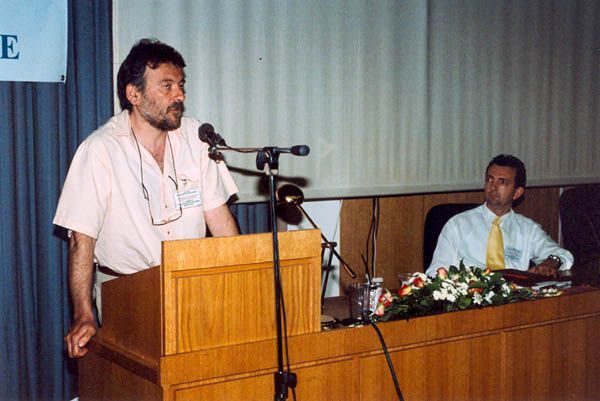
8th and final speaker in this Marathon of knowledge. And of course it could not have been any other than Mr. Vasilios Giannopoulos, Cave Diver, Doctor of Geology of the Ephorate of Paleoanthropology - Speleology and on what other topic?
Science & Cave Diving
We will say it again, speakers like Mr. Giannopoulos and with such a spectacular topic like this should be allocated much more time. We did not enjoy him as much as we should have at the 1st conference either. It is worth getting a very good taste of some of the material presented by Mr. Giannopoulos through the conference proceedings.
SCIENCE AND CAVING
Dr. V. Giannopoulos
Speleology is the branch of geological science that deals with the study of caves as natural phenomena. The causes of their creation, their morphology, and the sediments contained within them are the most basic units studied by this branch of geology.
Cave research begins with geological studies. This allows one to form a general first picture in order to plan the exploration method and the materials that will be needed. In addition, geological studies are a great help and prerequisite for other studies that may follow, such as paleontological, biological, archaeological, etc. The morphology of a cave contributes to the creation of a peculiar and almost stable environment within it. Its sediments have recorded all the important events and changes that occurred, both inside the cave and in the wider external space. The preservation over time of all these elements can be little affected by any internal or external change (weather conditions, etc.). Thus, their study today by specialist scientists gives a complete picture of the evolution and geological changes. Quite rightly, therefore, some have called caves "a window into the past". Tectonic movements, but also eustatic changes in sea level are among the main reasons why many caves in Greece have been completely or partially flooded by water. The exploration and study of these caves until a few years ago was impossible. Today, however, the development of diving techniques and sports speleology laid the foundations for a new exploration technique, Cave Diving. Three of the main cave diving and study programs of the corresponding caves, although still in progress, have yielded significant results.
ΒΟΥΛΙΑΓΜΕΝΗ
Underwater cave entrance
The total length of the corridors explored to date is 3,123 m. The furthest point is located 788 m. from the entrance, in a straight line, north, below the building blocks of the homonymous city. The study of the morphology and hydrology of the cave leads to the conclusion that the main speleogenesis took place at an older level of the aquifer.
VOULIAGMENI - Section along the development of the cave
The result of the cave's morphology, tectonics, stratigraphy, type of limestone and, more generally, positive conditions for speleogenesis are the large, old and new, detachments and collapses observed in the cave. The mixing of fresh water with seawater, which penetrates through the fractures of the limestone, was observed to take place at a depth of -16 to -40 m. At approximately the same depths, small changes in water temperature are also observed, which stabilizes from -40 m. and below at 27° C. The identification, moreover, of decoration and travertine-like deposits provides evidence for the existence of a dry environment in earlier times and, more generally, for the paleomorphology of the area. Simultaneously with the exploration and study of the underwater cave, a surface reconnaissance of the morphology of the wider area was carried out. Taking into account previous data, in combination with the on-site research, the already known karst depressions, the cave abyss "German" and the underwater karst conduit, known as "Pigadi", were identified. The research also proceeded to identify many other small depressions, but mainly four sinkholes. Perhaps the most important element that emerged was that all these underground and surface karst depressions have been created along a straight line in a North-South direction and belong to the same karst system.
VOULIAGMENI - Exploration
The continuation of this program is considered extremely necessary, mainly due to the social problem that has arisen from the existence of the largest underwater hall in the world (approximately 2,000,000 m3) under the building blocks.
ΣΠΗΛΑΙΑ ΕΛΕΦΑΝΤΩΝ
"Elephant" Cave, Vamos, Chania, Crete
Another cave diving was to be very important for the identification of paleontological findings and to contribute greatly to the promotion of science. In January 2000, television showed footage of G. Tzanakis from an underwater cave that M. Efthymakis had indicated. On March 31, 2000, the Ephorate of Paleoanthropology-Spelaeology, in collaboration with speleological associations and the Cretas Diving Center, organized the first expedition to explore the cave. The cave is located in the prefecture of Chania, outside the bay of Souda. It has been opened in Mesozoic limestone. Its entrance, 9 m wide and 6.5 m high, is currently underwater.
ELEPHANT CAVE - Entrance to the cave
The first part of the cave, approximately 40 m long, continues to be underwater. The remaining part, 125 m long and 2 m wide, which also constitutes the main chamber of the cave, has, due to its morphology, been partially flooded by water. The depth of the bottom in this chamber ranges from a few centimeters to 4 m, while the height of the ceiling above the water surface exceeds 10 m in some places. The lithic decoration is very rich throughout the cave, both above and below the water surface.
ELEPHANT CAVE - The great hall
The most important finding here, however, was the identification of paleontological material, which after an initial study, was found to consist mostly of elephant bones and a very small percentage of even-toed ungulates (Cervidae). This site is new for Crete and, compared to the other sites, is the only one under the sea. From the measurements carried out on the found parts of the elephant skeleton, it was possible to argue that this is a new species, which was named elephas chaniensis n.sp. Its size was larger than the current elephant and smaller than its ancestor, the antiquus.
ELEPHANT CAVE - Elephant molar
Η μελέτη των ιζημάτων (βιολογικών, κλαστικών και χημικών) καταδεικνύει με βεβαιότητα ότι το σπήλαιο σε παλαιότερες εποχές ήταν στεγνό.
Είναι γεγονός ότι και τα τρία μελετηθέντα σπήλαια βρίσκονται κατά μήκος της σημερινής ακτογραμμής και έχουν επηρεαστεί από τις ευστατικές κινήσεις του επιπέδου της θάλασσας, το οποίο έχει αποδειχθεί ότι, κατά τις παγετώδεις περιόδους, μετατοπίζεται έως και 150 μ. χαμηλότερα από το σημερινό. Συνεπώς, δεδομένου ότι, κατά μήκος των ακτογραμμών, πάντα παρατηρείται πιο έντονη παρουσία ανθρώπων και ζώων, είναι πολύ πιθανόν, ειδικά για τον ελλαδικό χώρο, να εντοπιστούν στο μέλλον και άλλα ανάλογα σπήλαια, που θα δώσουν νέα σημαντικά στοιχεία για τις διάφορες επιστήμες.
Σπήλαιο «Γλυφάδα» Διρού Λακωνίας
Το σπήλαιο βρίσκεται στο νομό Λακωνίας, στη χερσόνησο της Μάνης και απέχει περίπου 2 χμ. από την κοινότητα Πύργου Διρού.
Το όνομά του οφείλεται στο υφάλμυρο νερό που εκβάλλει στη θάλασσα από τη φυσική του είσοδο. Από την είσοδο αυτή και με σκοπό την ανεύρεση πόσιμου ύδατος, το 1923, οι κάτοικοι της περιοχής ανακάλυψαν τυχαία τις πρώτες αίθουσες του σπηλαίου.
Από το 1949 άρχισαν οι συστηματικές εξερευνήσεις. Το 1961, τα σπήλαιο αξιοποιήθηκε τουριστικά και μέχρι το 1992 είχαν χαρτογραφηθεί 6.200 μ. διαδρόμων με συνολική έκταση 34.100 μ2 . Από το 1987 και συστηματικότερα από τα 1994, η Εφορεία Παλαιοανθρωπολογίας-Σπηλαιολογίας, στα πλαίσια ενός ευρύτερου προγράμματος εξερεύνησης και μελέτης των σπηλαίων της
Μάνης, αρχίζει συστηματικές έρευνες στο σπήλαιο «Γλυφάδα» . Σήμερα το συνολικό μήκος των χαρτογραφημένων διαδρόμων έχει ανέλθει στα 10.606 μ., από τα οποία τα 1833 είναι υποβρύχια (σε αυτά δεν έχει υπολογιστεί το χερσαίο τμήμα που οδηγεί στον «πάνθηρα» ).
GLYFADA OF DIROS - 3D visualization of the cave
The development of the cave is very labyrinthine. The causes of this morphology are mainly due to the creation of the stalagmite decoration. The original form of the cave was much simpler, with the main directions of the faults, SE-NW and E-W. It has been opened up in crystalline limestones and today is partially flooded by water. Both its geographical location and the general prevailing conditions are also the cause of its complex morphology. Thus, in order to study it, the cave was divided into six different sections, based on its morphological variations. As was natural in this case, the greatest scientific interest was presented in the underwater part of the cave, which had remained unexplored, and therefore relatively protected. It is a paleokarst with many stalactites, even at a depth of -71 m. A common feature throughout the surface, not only of the bottom, but also of the walls of the underwater corridors, is the existence of mud, from 1 to 20 cm thick, which, following tourist exploitation and the blocking of the natural outlets, has become trapped inside the cave.
GLYFADA, DIROS - Exploration
The study of the underwater morphology showed four points of intense caving, with the most frequent occurrence of widening in the interval between -15 and -25 m. The erosion of the underwater decoration and the rock is evident throughout the section, with more pronounced characteristics from -6 m. and below. From this depth, a reduction in the decoration was also observed, with stalactites and stalagmites fewer in number and larger in size. Although in general in the cave the caving has stopped and we are in the phase of filling it with chemical, mainly, sediments, it continues at a rapid pace in the underwater section. However, apart from the morphological observations, the study of the paleontological material stood out from the multitude of other studies: during cave diving and research of the underwater section, large vertebrate bones were identified in various parts of the cave, and mainly where there were sandstone sediments. This finding resulted in the development of a separate program and special studies for this particular cave.
First, all the sites with paleontological findings were identified and detailed mapping was carried out, both on land and underwater. The arduous and often dangerous task of photographing and removing the paleontological material from the seabed concluded the first phase of the work. The second phase, in the laboratory, included the preservation of the bones, their photography, their design and their identification. The results were very significant: more than 200 intact bones and 400 bone fragments were collected. The largest percentage belonged to a hippopotamus of the species Ippopotamus amphibius, while for the first time in such a southern geographical point, hyena bones were discovered. Also found were bones from a panther, a lion, a ferret, artiodactyls, small rodents, birds and seal teeth. The dating that was done gave an age of approximately 32,000 years.
ΓΛΥΦΑΔΑ ΔΙΡΟΥ - Οστά Ιπποπόταμου
Very important are also the indications of human presence along with the paleontological findings. The continuation of the study requires the conduct of an underwater paleontological excavation, which is expected to provide much more data in all areas.
GLYFADA OF DIROS
Σπήλαιο «Γλυφάδα» Διρού Λακωνίας
Το σπήλαιο βρίσκεται στο νομό Λακωνίας, στη χερσόνησο της Μάνης και απέχει περίπου 2 χμ. από την κοινότητα Πύργου Διρού.
Το όνομά του οφείλεται στο υφάλμυρο νερό που εκβάλλει στη θάλασσα από τη φυσική του είσοδο. Από την είσοδο αυτή και με σκοπό την ανεύρεση πόσιμου ύδατος, το 1923, οι κάτοικοι της περιοχής ανακάλυψαν τυχαία τις πρώτες αίθουσες του σπηλαίου.
Από το 1949 άρχισαν οι συστηματικές εξερευνήσεις. Το 1961, τα σπήλαιο αξιοποιήθηκε τουριστικά και μέχρι το 1992 είχαν χαρτογραφηθεί 6.200 μ. διαδρόμων με συνολική έκταση 34.100 μ2 . Από το 1987 και συστηματικότερα από τα 1994, η Εφορεία Παλαιοανθρωπολογίας-Σπηλαιολογίας, στα πλαίσια ενός ευρύτερου προγράμματος εξερεύνησης και μελέτης των σπηλαίων της
Μάνης, αρχίζει συστηματικές έρευνες στο σπήλαιο «Γλυφάδα» . Σήμερα το συνολικό μήκος των χαρτογραφημένων διαδρόμων έχει ανέλθει στα 10.606 μ., από τα οποία τα 1833 είναι υποβρύχια (σε αυτά δεν έχει υπολογιστεί το χερσαίο τμήμα που οδηγεί στον «πάνθηρα» ).
GLYFADA OF DIROS - 3D visualization of the cave
The development of the cave is very labyrinthine. The causes of this morphology are mainly due to the creation of the stalagmite decoration. The original form of the cave was much simpler, with the main directions of the faults, SE-NW and E-W. It has been opened up in crystalline limestones and today is partially flooded by water. Both its geographical location and the general prevailing conditions are also the cause of its complex morphology. Thus, in order to study it, the cave was divided into six different sections, based on its morphological variations. As was natural in this case, the greatest scientific interest was presented in the underwater part of the cave, which had remained unexplored, and therefore relatively protected. It is a paleokarst with many stalactites, even at a depth of -71 m. A common feature throughout the surface, not only of the bottom, but also of the walls of the underwater corridors, is the existence of mud, from 1 to 20 cm thick, which, following tourist exploitation and the blocking of the natural outlets, has become trapped inside the cave.
GLYFADA, DIROS - Exploration
The study of the underwater morphology showed four points of intense caving, with the most frequent occurrence of widening in the interval between -15 and -25 m. The erosion of the underwater decoration and the rock is evident throughout the section, with more pronounced characteristics from -6 m. and below. From this depth, a reduction in the decoration was also observed, with stalactites and stalagmites fewer in number and larger in size. Although in general in the cave the caving has stopped and we are in the phase of filling it with chemical, mainly, sediments, it continues at a rapid pace in the underwater section. However, apart from the morphological observations, the study of the paleontological material stood out from the multitude of other studies: during cave diving and research of the underwater section, large vertebrate bones were identified in various parts of the cave, and mainly where there were sandstone sediments. This finding resulted in the development of a separate program and special studies for this particular cave.
First, all the sites with paleontological findings were identified and detailed mapping was carried out, both on land and underwater. The arduous and often dangerous task of photographing and removing the paleontological material from the seabed concluded the first phase of the work. The second phase, in the laboratory, included the preservation of the bones, their photography, their design and their identification. The results were very significant: more than 200 intact bones and 400 bone fragments were collected. The largest percentage belonged to a hippopotamus of the species Ippopotamus amphibius, while for the first time in such a southern geographical point, hyena bones were discovered. Also found were bones from a panther, a lion, a ferret, artiodactyls, small rodents, birds and seal teeth. The dating that was done gave an age of approximately 32,000 years.
ΓΛΥΦΑΔΑ ΔΙΡΟΥ - Οστά Ιπποπόταμου
Very important are also the indications of human presence along with the paleontological findings. The continuation of the study requires the conduct of an underwater paleontological excavation, which is expected to provide much more data in all areas.











